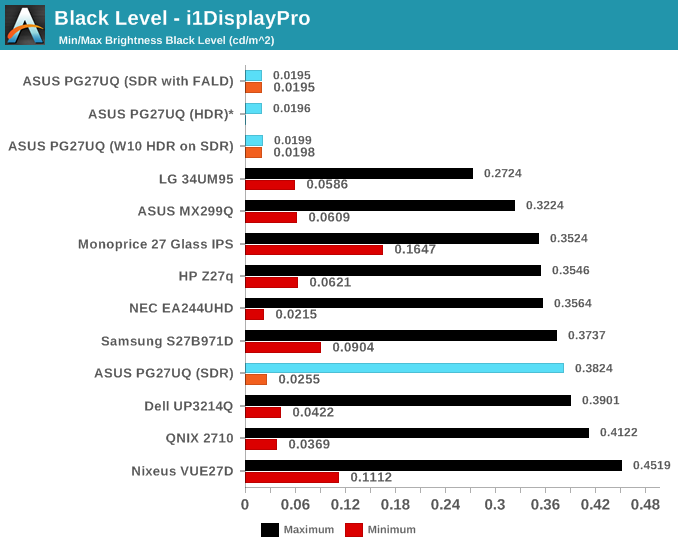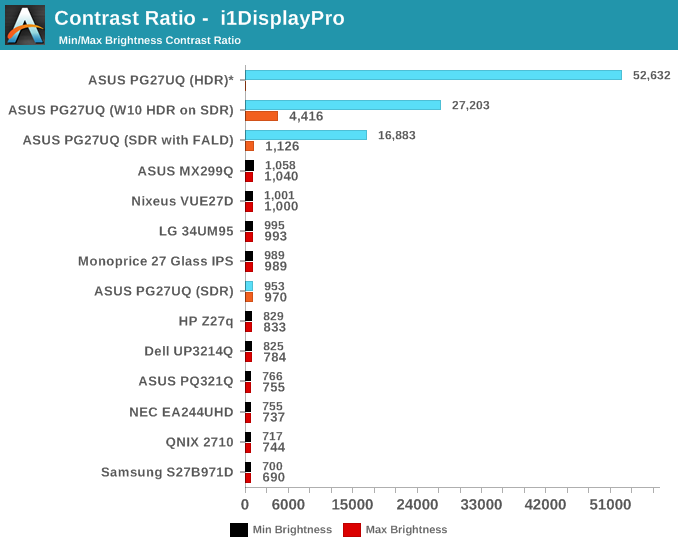The Asus ROG Swift PG27UQ G-SYNC HDR Monitor Review: Gaming With All The Bells and Whistles
by Nate Oh on October 2, 2018 10:00 AM EST- Posted in
- Monitors
- Displays
- Asus
- NVIDIA
- G-Sync
- PG27UQ
- ROG Swift PG27UQ
- G-Sync HDR
Brightness and Contrast
Going straight into the brightness and contrast metrics, we know HDR's calling card is to permit those bright whites and dark blacks. For DisplayHDR 1000, and UHD Premium, 1000 nits (the common non-SI term for cd/m2) is the requirement. So for brightness of white levels, it's no surprise that in HDR mode the PG27UQ reaches that coveted mark.
Outside of HDR, brightness is also useful in gauging visibility/usability in conditions of bright and direct ambient light, i.e. outdoors. For moderately lit indoor use, the typical 200 to 300 nit range of desktop monitors is more than sufficient. In terms of factory defaults, the PG27UQ is set at 80 for brightness, which is around 266 nits. 1000 nits is much too bright for day-to-day usage, as is 500 nits.

*In HDR mode, there is an adjustable 'reference white' setting, defaulted at 80 nits, instead of a brightness setting. At that default setting, the PG27UQ displayed the HDR test pattern at 1032 nits.
Because HDR has a static 'reference white' level instead of brightness, there isn't really an equivalent to minimum brightness white level as it isn't utilized in the same way; for the PG27UQ, reference white can be set between 20 to 300 nits.
Otherwise, enabling the Windows 10 'HDR and Wide Color Gamut' mode puts the monitor into its HDR mode; additionally, that Windows 10 setting provides a brightness slider governing SDR content while in HDR mode. So at 100% SDR brightness, the display pushes past 500 nits. For users, it works nicely to avoid SDR dimness when HDR is enabled, and also providing the option to boost up to much higher brightness if desired.

*Represents black levels corresponding to the default 'reference white' setting of 80 nits.
IPS-type panels are often known for their 'backlight bleed' and so relatively higher black levels. Without its local dimming capability, the PG27UQ isn't much of an exception. Enabling variable backlighting (FALD) in the OSD brings the black levels to HDR tier performance, and can be enabled on SDR mode at the cost of maximum brightness white levels.

*Contrast ratios calculated from default reference white of 80 nits
The good range between bright whites and dark blacks translate into high contrast ratios for the PG27UQ. While we don't have any other HDR monitors for comparison, the contrast ratios are really in their own class, especially as only HDR content will take advantage of the brightness and be (properly) displayed. Otherwise, in pure SDR mode, the PG27UQ resembles a solid IPS-type SDR monitor. Just enabling the direct LED backlighting in SDR mode improves contrasts considerably on the strength of its black levels.










91 Comments
View All Comments
lilkwarrior - Monday, October 8, 2018 - link
SLI & Crossfire are succeeded by DX12's & Vulkan's explicit multi-GPU mode. Nvidia deleiberately even ported NVLINK (succeeds classic SLI) to RTX cards from Quadro+ cards but without memory pooling because DX12 & Vulkan already provides that for GPUs.Devs have to use DX12 or Vulkan and support such features that is easier for them to consider now that Windows 8 mainstream support is over + ray-tracing that's available only on DX12 & Vulkan.
nathanddrews - Wednesday, October 3, 2018 - link
Still cheaper than my Sony FW-900 CRT was when it was brand new! LOLHixbot - Wednesday, October 3, 2018 - link
Still not better than a fw-900 in many ways. This LCD doesn't have a strobing feature to reduce eye tracking motion blur.nathanddrews - Wednesday, October 3, 2018 - link
No argument there, but my FW900 died, so the options are few...Crazyeyeskillah - Wednesday, October 3, 2018 - link
my fw-900 is also dead in my closet, hoping of resurrecting it one day. Right now I got another excellent crt monitor I found to game on: Sony Multiscan E540 : It's not as big, but god damn is it smooth and flawless.By the time this crt dies, hopefully LCD tech won't be such garbage trying to make workaround for its inferior tech for gaming.
nathanddrews - Thursday, October 4, 2018 - link
Yeah, I've moved on to a Sony C520K for the last ~2 years. In use I think it's far better than my FW900 was in terms of contrast/color plus I'm able to push slightly higher refresh rates, but it's not widescreen. I have bought a couple expensive G-Sync displays, hoping for an adequate replacement, but ended up returning them. I'm really hoping that this CRT lasts until MicroLED hits the market and that mLED can truly combine the best attributes of LCD and OLED without any of the drawbacks.Ironchef3500 - Wednesday, October 3, 2018 - link
100%Tunnah - Tuesday, October 2, 2018 - link
I don't get the point. You don't need the features for desktop work, so this is purely a gaming feature. Why not get an equally capable OLED/QLED at a much bigger size for less money ?Inteli - Tuesday, October 2, 2018 - link
TVs don't support native high refresh rates from sources like monitors do (I think LG's does, but only from USB sources or something like that) or adaptive refresh rates. It's a gaming monitor, so it has gaming-specific features.imaheadcase - Tuesday, October 2, 2018 - link
You answered own question, because its a gaming monitor. You can't find one like this (yet) that offers all the things it does.You like many people are confused on this website about TV vs monitors. A TV equal size, same resolution, is not the same as a dedicated monitor. A LG OLED 55 inch TV looks pretty bland when you use a PC monitor for gaming.